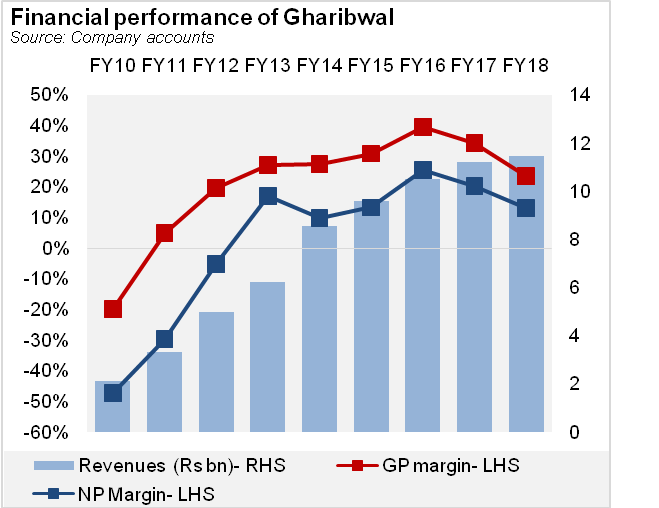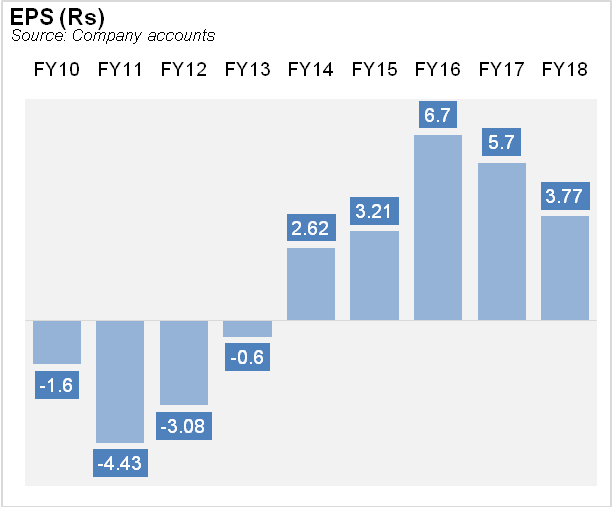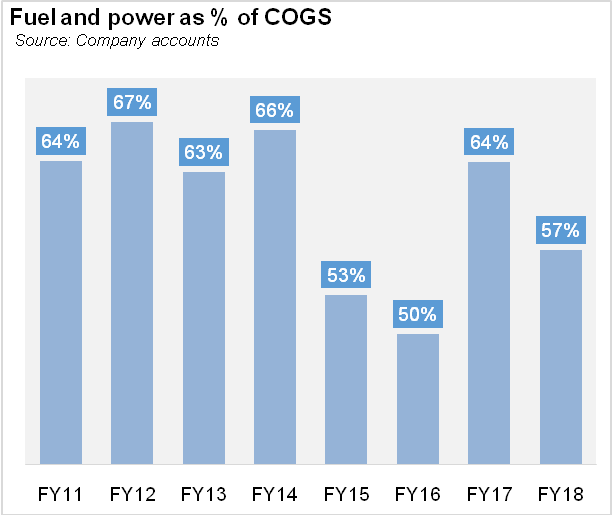Located in district Chakwal of Punjab, Gharibwal Cement (PSX: GWCL) is one of the mid-tier cement manufacturers supplying cement mainly to the northern side of the domestic market. The company was incorporated in 1961, started its operations in 1965 (with an annual capacity of 360,000 tons), nationalised in 1972 and later denationalised in 1993. Through the year, the company went through a series of expansions. It merged with GCL Electric with power generation capacity of 10MW in 2003, later adding on two gas power generators of 12 MW.
In 2009, another plant of more than an annual 2 million tons capacity was added with three dual-fuel power generators of 16MW. Two years later, the company discarded its old plant-an annual capacity of 540,000 tons-left with the 2 million tons of capacity which its current facilities are using. In 2013, Gharibwal upgraded its electric grid stations and more recently, the company invested in a 20 MW of a Waste Heat Recovery (WHR) unit and a downhill conveyor belt to improve the operational performance of its plant. Based on capacity, the company has a share of nearly 5 percent in the market overall, though it is higher if only the north zone is considered.
Shareholders and investments Nearly 89 percent of the company's shares are held by the directors and their families of which the CEO holds more than 56 percent of the shares. Some shares are held by joint stock companies, banks and modrabas and foreign companies. The public held more than 6 percent shares as at June 30, 2018.
Gharibwal has been providing loan facilities to its associate company Balochistan Glass Limited which manufactures glass containers, tableware glass products and plastic shells for beverage companies. In 2018, the year-long facility of Rs500 million including a letter of credit facility for working capital needs. This loan earns Gharibwal a markup of 1 percent above the rate charged by banks and financial institutions.
Gharibwal has been investing in improving its plant facilities. In the outgoing fiscal year, the company brought a new vertical cement mill of 250tph that enhances the cement grinding capacity of the plant. During 2017, it successful capitalized two BMR projects of waste heat recovery plant and down-hill conveyor belt. Meanwhile, a new clinker storage silo of 150,000-ton capacity is under progress which will enhance the clinker storage capacity and reduce the handling and transportation cost of clinker stock.
Operational and financial performance Gharibwal has substantially raised production over the years after bringing its new plant into operation and discarding its old plant in 2011. The new plant also raised capacity utilisation substantially, in the most recent years boasting above 80 percent. Increasing demand locally has allowed Gharibwal much like the rest of the industry to raise its revenues over the years. Revenues nearly doubled since 2013 till date.
Fuel and power costs tend to be high for cement manufacturers being an energy intensive industry. But with the Balancing, Modernization and Replacement (BMR) conducted by the company, Gharibwal managed to reduce fuel and power costs as share of cost of sales from 64 percent in FY11 to 50 percent in FY16, but back up to 64 percent in FY17 and down to 57 percent in FY18. The real culprit is coal.
Margins have fluctuated and come down from 40 percent to 24 percent between FY16 and FY18. Coal which is mostly imported carries a high weight in the cost equation for cement manufacturers. According to the company's annual report, the increase in coal prices raised the cost per clinker by 22 percent during FY18 while higher prices for gas, furnace oil and grid electricity also contributed to higher costs. Since a lot of fuels of imported, the depreciating rupee against the greenback did not help matters on the cost department. However, the company claims that its own electricity production (43% of total) cushioned the blow to an extent. Margins did fall but could have fallen by a much larger percentage.
The capital expenditure will cause future finance costs to increase. Net profit margins have followed the same trends as gross margins since net indirect expenses have remained more of less the same.
Latest financials and industry dynamics In the latest first quarter financial results, Gharibwal recorded a 12 percent decline in dispatches resulting in an 8 percent decline in revenue. The fall in demand in the north zone, particularly now that the sector is expanding, will remain a trend throughout the fiscal year. Aside from the potential implementation of the Naya Pakistan Housing Plan-that will fill the housing shortage by 5 million houses-or the construction of new dams-of whose future remains in hot water, there are no indicators that suggest a strong growth in local cement demand.
Though CPEC projects are on track, a lot of schemes under the PSDP were slashed from the plans. The new mini budget is expected to cut down on the development expenditure further. Construction demand could get affected. Moreover, a slowdown in the economy, and the rising level of uncertainty could translate into reduced activity in the real estate market. Restriction on non-filers purchasing property will curb private sector construction. The new mega deal signed between Pakistan and China for residential projects in Gwadar could open new avenues but it will assist the players located in the south much more, if local cement is actually used.
In the fiscal year, the company will have to manage its inventory better to offset the negative effects of rising coal prices and weakening local currency. As expansions come through, and local demand wanes, cement may fetch lower prices in a more price competitive environment. This will further affect margins going forward.



=================================================== Gharibwal Cement (Financial performance in Q1) =================================================== Rs (mn) Q1FY19 Q1FY18 YoY =================================================== Sales 2,480 2,692 -8% Cost of Sales 1,820 2,044 -11% Gross Profit 660 647 2% Administrative 99 99 0% Distribution costs 9.4 5.3 77% Other operating expenses 68.1 31.4 117% Other income 7.1 7.0 1% Finance cost 102.3 95.6 7% Profit before tax 389 423 -8% Taxation 119 121 -2% Net profit for the period 270 302 -11% Earnings per share (Rs) 0.67 0.75 -11% Dispatches (tons) 369,597 421,501 -12% GP margin 27% 24% 11% NP margin 11% 11% -3% ===================================================
Source: PSX notice
======================================================== Pattern of Shareholding (as on June 30, 2018) ======================================================== Categories of Shareholders Share ======================================================== Directors and their spouse(s) and minor children 88.8% Mr. Abdur Rafique Khan 22.7% Mr. Muhammad Tousif Peracha- CEO 56.3% Mr. Nazir Ahmed Peracha 0% Mr. Muhammad Niaz Peracha 0% Mr. Ali Rashid Khan 4.0% Mr. Daniyal Jawaid Parcha 0.0% Mrs. Tabassum Tousif Peracha 0.1% Mrs. Amna Khan 5.7% Mrs. Salma Khan W/O A. Rafique Khan 0.0% Modarabas and Mutual Funds 0.02% Joint Stock Companies 0.37% Foreign Companies 2.9% Associations 0.01% Others 0.2% Banks, development finance institutions, 1.49% non-banking finance companies etc. General Public 6.2% Total 100% ========================================================
Source: Company accounts

























Comments
Comments are closed.